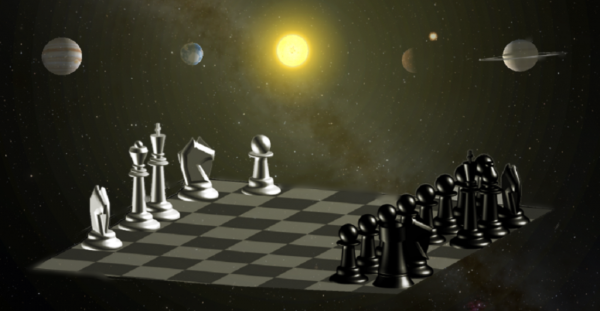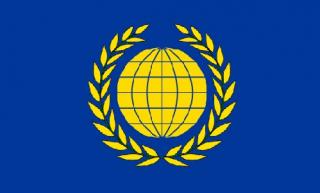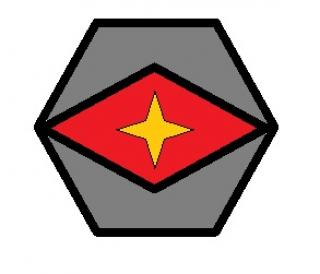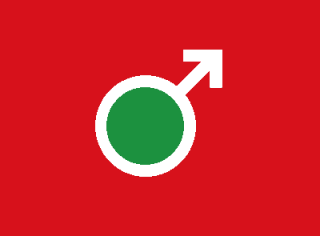BY LETTER
Solsys Geopolitics 2100 - 2500 CE (131 - 531 AT)
History > 0030 to 0900 AT: Solsys Era
History > 0030 to 0900 AT: Solsys Era > 130 to 400 AT: The Interplanetary Age
History > 0030 to 0900 AT: Solsys Era > 400 to 530 AT: The Solsys Golden Age
History > 0030 to 0900 AT: Solsys Era > 530 to 900 AT: The Sundering
Culture and Society > Politics & Government
History > 0030 to 0900 AT: Solsys Era > 130 to 400 AT: The Interplanetary Age
History > 0030 to 0900 AT: Solsys Era > 400 to 530 AT: The Solsys Golden Age
History > 0030 to 0900 AT: Solsys Era > 530 to 900 AT: The Sundering
Culture and Society > Politics & Government
Solsys Geopolitics 2100-2500 CE |
 Image from Steve Bowers |
The 22nd to 26th centuries CE of the Interplanetary and Golden Ages witnessed the beginning of Terragen civilization's spread from its cradle on Earth into the vast frontier of space. Conflict and rivalry between polities, a factor present during all periods of human history, continued as nation-states and an expanding array of new political actors sought to secure their interests throughout the Solar System. As with most events occurring before the Technocalypse, records attesting to the geopolitical situation are often incomplete and of questionable veracity. Furthermore, access to Earth for archaeology is extremely limited due to GAIA. However, over the millennia researchers have been able to piece together a rough chronology accepted by a number of modern mainstream historians.
Defining geopolitical characteristics of this time include:
- Nation-states, especially on Earth, remained the primary form of large-scale political organization throughout this period although there was a significant increase in the influence of non-state actors such as corporations, virtual communities, and genetics based clades.
- Earth-based nations, organizations, and businesses dominated nearly all of the Inner Solar System, although their influence decreased dramatically further away on the outer planets.
- A leveling of geopolitical influence on Earth by the slow but steady shift of relative power from nations in Europe, North America, and Northeast Asia to countries in Africa, South America, Oceania, Southeast Asia, and the Indian subcontinent.
- A gradual weakening of national sovereignty with increasing integration of global economic, transportation, communication, and environmental systems.
- International relations characterized by the virtual absence of direct state-on-state hostilities but frequent rivalries, competitions, skirmishes in remote regions of the solar system, and covert or asymmetrical modes of conflict.
2100-2199
Flags of the Free State of Cascadia, the California Republic, and the Independent Republic of Siberia |
 Image from Steve Bowers and MacGregor |
While the preceding century was largely defined by the rivalry between the United States and China, the globe developed into a truly multi-polar world by 2100 CE. Although China and America were still considered great powers, they were joined by the likes of Brazil, India, East Africa, and the European Federation. Some have labelled the early 22nd Century as the "high-water mark of nationalism" as the planet's 10 billion inhabitants were divided into well over 200 different nation-states. However, things soon began to change. In 2120, the world economy entered a severe recession known as the Great Downturn (151-158 AT). A dramatic increase in unemployment was the primary cause of the economic crisis, with AI and robots replacing human labor across a swath of jobs once thought safe from automation. Other destabilizing factors included global warming and the transition to a fusion-based economy, which stripped certain regions, such as the Middle East, of their former importance as sources of hydrocarbon fuels. The economy, often with governmental assistance, eventually stabilized but left a radically altered political landscape that varied greatly depending on location. The People's Republic of China was transformed into the more decentralized Syndicate of Chinese Provinces (SCP), while the countries of South America sought greater integration, creating the Organización Sudamericana Supranacional (OSS). Indonesia made a series of sweeping political and economic reforms that started its long ascent to becoming a world power as illustrated by its construction of the first Earth-based space elevator in 2170 (201 AT). A variety of transnational and secessionist movements, often labeled "new regionalism," spread across the world in an attempt to deal with a host of global issues such as climate change, AI rights, animal provolution, and human cladization. These included the Cascadia and Second California Republic movements in North America and the establishment of the Independent Republic of Siberia in Asia to name just a few. Furthermore, rising sea levels caused by human-made climate change, which reached their peak at the end of the century, displaced millions of people and destabilized many countries.
Flag of the Inner Council |
Image from MacGregor |
Off-world expansion, both governmental and commercial, accelerated in the decades following the Great Downturn due to diminishing costs and increased space industry, going from just a few small permanent outposts to dozens of colonies stretching from Mercury to Saturn. The establishment of colonies accelerated further after the opening of the first space elevator brought the cost of access to space to unprecedented lows. While most of these settlements remained politically tied to their home nations or corporations back on Earth, a larger number began acting autonomously or even achieved de facto political independence. In 2135 (166 AT), a number of Superior dominated stations and habitats around Earth banded together to form the Orbital League, which some historians consider to be the first true space-based polity. With the United Nations struggling to adapt to the growing amount of off-world settlement, an independent Council for the Peaceful Coordination and Development of the Inner Solar System (CPCDISS) was created in 2184 (215 AT). CPCDISS, soon invariably referred to as the Inner Council, did a passable job of mitigating conflict among state and non-state actors between Sol and the Asteroid Belt. However, the Outer Solar System often remained a dangerous place, as illustrated by the conflict between colonists and antimatter miners over Amalthea in 2189 (220 AT). Although some historians disagree, it is usually thought that the Inner Council was never a sovereign political entity but more of a forum for de-conflicting the interests of major spacefaring Earth nations, corporations, and a small but growing number of orbital and offworld states. A mere nine years after its founding, the Inner Council oversaw the creation of the Martian Union, a supranational entity for fostering economic and political relations between the various colonies and settlements. Among its many duties, the Martian Union coordinated and facilitated the ongoing terraforming efforts.
2200-2299
Cislunar Alliance Flag |
.png) Image from MacGregor |
During the 23rd century, a number of new political groupings emerged on Earth. These included the South Asian Compact (SAC) in 2217 (248 AT), a supranational organization led by India that promoted regional integration and development. The SAC would oversee the construction of the Vahana space elevator in the Maldives, Earth's sixth and final pre-Technocalypse beanstalk. In the extreme South, dozens of settlements operating under the United Nations Organization for Regulating Colonization of the Antarctic were granted independence in 2221 (252 AT), becoming 32 "Free States" loosely governed by the Antarctic Conclave. Another new alliance was the North American Community (NAC). Formed in 2238 (269 AT), the NAC greatly strengthened the bonds between the United States, California, Cascadia, Mexico, and the various Canadian and Central American states. Overall, geopolitical power during this period continued to drift south with Australia, Indonesia, SAC, OSS, and an assortment of African coalitions cementing their place in the ranks of the leading Earth nations of the day. Intercontinental transportation reached an all-time level of affordability facilitated in part by a highly developed network of vac-trains that spanned the globe. This, and the near ubiquitous translation technology, allowed individuals with various interests and political orientations to more easily interact regardless of nationality or location.
Off Earth, in 2244 (275 AT) the Orbital League was recast as the Cislunar Alliance which dominated the increasingly crowded volume between Earth and Luna. Due to its influence, the Cislunar Alliance secured a much-coveted seat on the Inner Council. More distantly, by 2249 (280 AT) several colonies on Ganymede, Callisto, Io, and Europa formed the Jovian League and increasingly acted as an independent polity although many were still nominally tied to their Inner System benefactors. The relative importance of the Jovian League increased dramatically in 2278 (309 AT) when the Cislunar Alliance imposed an export tariff on Helium-3. This forced many of the Belt colonies to rely on the Jovian League for this important fuel resource. Furthermore, as with other places in the Outer Solar System, the lengthy travel and communication times and their exclusion from full participation in the Inner Council facilitated the creation of a separate identity. In response to the growing clout and independence of off-world actors, many Earth based nation-states expanded their military presence in space such as the resurgent United States launching the USS Randolph in 2284 (315 AT).
2300-2399
Flag of the Council of Earth |
 Image from MacGregor |
The United Nations officially dissolved in 2303 (334 AT) and was replaced by the Council of Earth (CoE). Unlike the strictly nation-based UN, the CoE allowed for representation by non-state actors such as certain multinational corporate conglomerates, as well as transnational advocacy groups for the growing population of AI, splices, and cyborgs. Furthermore, while planetary temperatures had already begun to stabilize over the last several decades, the CoE had much greater powers to ensure the accelerated reversal of climate change. Like the UN, the CoE continued to enforce rather conservative technological policies such as the ban on destructive uploading. Unlike the UN, the CoE largely gave up trying to influence events beyond Low Earth Orbit. Over the course of the 24th century, a host of new political entities began to emerge on Earth. Often these included clade-specific or ideologically based quasi-states. Many of these were located in or under international waters such as the Doggerland Commonwealth and New Mu City. However, the balance of power continued to favor more traditional nation-states, some of which underwent surprising revitalization such as Iran, Algeria, Japan, and even a truncated Russia. Increasingly, Africa became the geopolitical fulcrum for the planet, as it garnered a larger percentage of the Earth's population, economic clout, and cultural vitality.
Mars witnessed a huge increase in population during this time, and reached nearly a billion inhabitants by the end of the century. Politically, the Red Planet remained divided between various Earth country enclaves, corporate holdings, and an ever-increasing number of independent territories, nearly all operating under the Martian Union umbrella. In the Outer Solar System, the Jovian League was ultimately subverted and then absorbed by the Genetekker dominated Gengineer Republic. Mining and export of Helium-3, along with its clear superiority in gengineering, allowed the Gengineer Republic to become the single most powerful polity in the Solar System and exert influence far above what the Jovian system's population would normally warrant. Although the Gengineer Republic's power still paled in comparison when considering Earth in the aggregate, it engaged in an intermittent but long running cold war with the Inner Council. Helium-3 extraction drove rapid development on the other outer planets. Often this was done by Genetekkers, such as in the Saturnian Ring Territory, but other groups of colonists were not uncommon. Most, but by no means all, of these new settlements were politically unaffiliated with any polities on Earth or in the Inner System. A notable example was the Cishp Bind on Titan, which in conjunction with several corporations, became an important player in the refined volatiles market.
2400-2499
Symbol of the Rojiqali Vecs |
 Image from MacGregor |
By the start of the 25th century, Terragen civilization had transitioned into the Solsys Golden Age, which witnessed the proliferation of transformative technologies throughout the Solar System. The development of inexpensive and accessible nanotechnology had a profound effect on political power structures, as new settlements could be constructed more easily and faster than ever before. This included the bubble habitats in the gaseous outer planets, which increasingly flourished. However most of the these 'floater' or 'inworlder' polities, to use local parlance, remained minor powers compared to more established 'outworlder' societies. By the end of the century, Saturn and its moons were heavily industrialized with nearly 1.4 billion inhabitants. While a sizable number remained tied to the Inner System, if only nominally, a veritable kaleidoscope of groups, clades, and sects called it home, including the invasive Rojiqali vec culture, deemed by some to be little better than an infestation. Hundreds of small but growing colonies were seeded throughout the Kuiper Belt, with the largest concentration on Pluto. During this century, interstellar colonization missions began to be launched. Tellingly, few were headed by traditional Earth nation-states, with polities like the Gengineer Republic and off-world corporate conglomerates taking the lead. In the Inner System, the Martian Union increasingly acted as if it were a unified independent state, often vocally disagreeing with the rest of the Inner Council on a number of matters. Regardless of these differences, the Martian Union, Council of Earth, and especially the Cislunar Alliance remained united in their longtime rivalry with the Gengineer Republic. These renewed tensions occasionally turned violent as illustrated by the rogue Black Fire terrorist attacks.
Flag of the Martian Union |
 Image from MacGregor |
On Earth, centuries of planetary engineering had finally reduced the effects of global warming back to near Information Age levels, albeit only with the assistance of extensive automated envirotech systems. The much-improved conditions rejuvenated several regions. These included the Sahara and Sahel of Africa, which served as the world's breadbaskets through extensive irrigation. Politically, the 25th century saw a great consolidation of states into either larger nations, or more commonly, expansive coalitions in order to compete with the growing clout of off-world powers. Although the veracity of records immediately preceding the Technocalypse can be particularly troubling, many historians list the Federated States of Africa, South Asian Union, and the League of the Americas and Australasia as the most powerful of the Earth-based nations and alliances. Despite this consolidation, non-state actors continued to grow and challenge the political order. This can be seen by the sometimes violent clashes between the cold weather adapted tweaks of the Niflheim Commune and the government of the Republic of Greenland over clade autonomy. While already in terminal decline, the near 900-year reign on Earth's surface of the nation-state would come to an abrupt end with the Technocalypse, the rise of GAIA, and the Great Expulsion.
Related Articles
Appears in Topics
| 0030 to 0900 AT: Solsys Era | 130 to 400 AT: The Interplanetary Age | 400 to 530 AT: The Solsys Golden Age |
| 530 to 900 AT: The Sundering | Politics & Government |
Development Notes
Text by MacGregor
Initially published on 28 March 2018.
Initially published on 28 March 2018.






